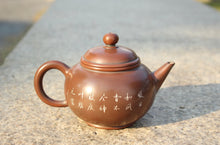
Photos are of actual teapot. Only 1 available.
Capacity: 205ml
This teapot was handmade in the Li Brother's Studio with lotus carving by Li Changquan 黎昌权. The characters were carved by Qiu Yi Feng 邱一峰 a master calligrapher in the nixing carving community. Qiu Yi Feng has recently retired and this is one of the last teapots on which he has worked. The Chinese characters read 暖日和风香不尽,伸枝展叶碧无穷。 This is a poem that can be loosely translated to: "Warm sun with soft wind brings the unstoppable fragrance, stretching branches and leaves along with endless green."
Mr. Li Changquan, who carved the lotus, has over 50 years experience making Nixing Clay Teaware, having first learned the art when in his teens. He is known for his beautiful nixing carvings that have won him numerous awards and praise.
These are wheel thrown Nixing clay teapots. Each are handmade using Nixing Guangxi Clay. The teapot walls are thin-medium thickness. The clay has a mottled, dark grey to bronze brown color which varies between each pot and is a result of the clay's natural colors and the process of firing the clay.
About the Clay
Nixing Clay pottery is one of the 4 famous types of Chinese ceramics, which include Yixing Zisha. Nixing ceramics are made in Qinzhou, Guangxi. The art is quite old, having been practiced over 1000 years. The clay is found in the surrounding area of Qinzhou, is environmentally friendly, and is used without adding any glaze, paint or other chemicals, making it a safe and healthy clay for use in teaware. Nixing clay is prized for its ability to take on a patina with use, like yixing, and for its degree of porosity. The clay is less porous than zisha but more than porcelain, making it a good clay for use when brewing oolong (similar use to Zhuni Zisha).
You can read more about Nixing clay here.
Preparation Before Use
Nixing Teapots should be prepared before using the first time. This is called "opening the pot". It removes any remaining dust from the teapot.
We recommend rinsing the teapot under warm water two or three times, then filling the teapot with boiling water and emptying it out two to three times. After this the teapot is ready for use.



























